How to care for a home on the National Register of Historic Places

Joseph Guidice lives a half-mile from the William T. Lauder Museum, which preserves the artifacts and history of Amityville.
But he once had a guest in his home who remarked, “This is the real Amityville museum.”
For almost 18 years, he and his wife, Barbara Guidice, have been living in a Queen Anne Victorian and filling it with antiques. From porcelain tea sets to a working music box from 1895, to a green water pump in the backyard from 1912, the property has history inside and out. It has earned a spot on the National Register of Historic Places, the only house in Amityville with this distinction, says Guidice.
“Let’s face it,” he says, “no matter what, you have to be a certain type of person to buy a house like this."
As of early January, there are 338 properties listed on the National Register of Historic Places in Suffolk County, and 154 in Nassau, according to the digital database. That includes residential homes, churches, post offices — even the Long Island Rail Road station in Farmingdale.
Being on the National or New York State Register of Historic Places protects centuries-old properties, and ensures their preservation for years to come. Homeowners also become eligible to apply for certain tax credits and gain official recognition through a ceremony and plaque for their house.
Of course, maintaining such homes require labor, money and attention. But when you’re as dedicated as these homeowners are, it’s all time well spent.
A passion project
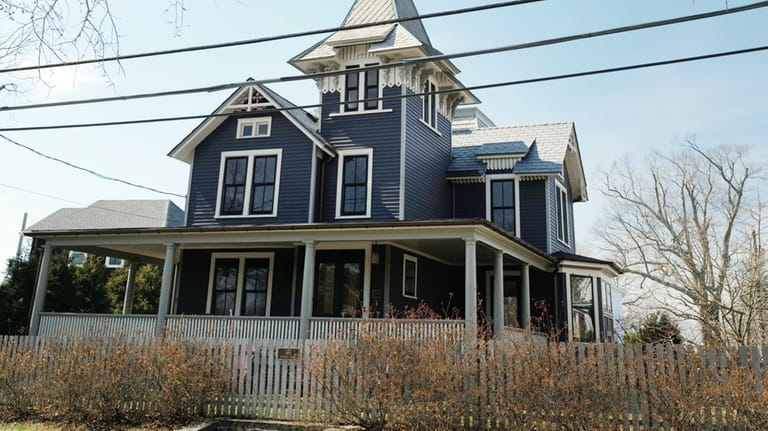
Jackie Doyle’s Queen Anne Victorian house in Sea Cliff is one of several she has bought and restored. Credit: Debbie Egan-Chin
Jackie Doyle restores historic homes as a hobby.
“This is my third,” says Doyle, whose 1886 Queen Anne Victorian lives on a corner in Sea Cliff. It’s been hers for six years — she moved after refurbishing a historic home in Roslyn.
“I buy homes that are in varying degrees of disrepair,” says Doyle. “I basically bring them back.”
Her Sea Cliff gem proved to be a project. From the roof to the septic system, it seemed that just about everything needed to be fixed. Doyle remembers her real estate agent saying, “This is a total train wreck.”
But the house had a solid foundation, and Doyle was up for the challenge. With help from her network of carpenters from previous restorations, the plumbing, electricity and roof were totally repaired. She also had the front deck redone with mahogany flooring.
The house is three stories tall, with three bedrooms and two full bathrooms. According to records from the New York State Office of Parks, Recreation and Historic Preservation, the house was built during a period of transformation in Sea Cliff — what was once a camp meeting ground turned into a trendy getaway spot, with summer houses being built throughout the village.
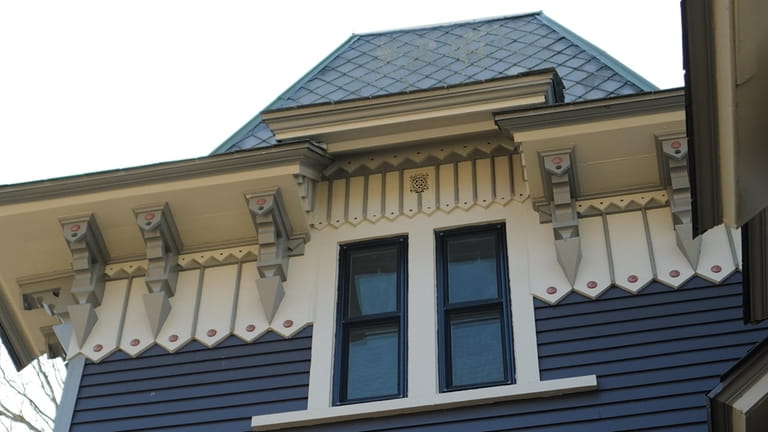
“I love this house so much and put so much work into it,” Doyle says. “It’s very special to me.” Credit: Debbie Egan-Chin
The interior of the home is now sleek and modern, more comparable to a Restoration Hardware showroom than a Victorian estate, says Doyle. Her vision extends outside to the porch, where there are salmon-colored rocking chairs that Doyle painted herself.
As long as a homeowner isn't using state or federal funds or permits to complete a renovation, they can "remodel, alter, paint, manage, subdivide, sell, or even demolish" a property on the National or State Register of Historic Places, according to its FAQ. The only requirement is that the project complies with local zoning.
Some villages have certain standards for historic properties. In 2017, Doyle decided to change the color of the house's exterior, referring to its time period while choosing a hue.
"It was difficult to manufacture colors back then," she says. "They typically used colors from the earth [to paint houses], so beets, berries or nuts.”
Villages (including Roslyn, Doyle says) sometimes require homeowners to honor this rule when repainting. Although Sea Cliff does not, Doyle chose keep the exterior authentic and opted for mulberry. The job cost about $30,000 at the time, she says, adding that the cost would probably be closer to $50,000 now.
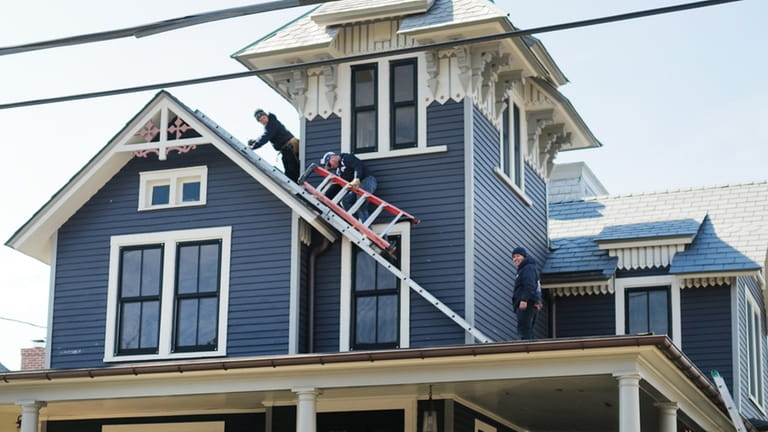
Roofers work Jackie Doyle's Queen Anne Victorian house in Sea Cliff. Credit: Debbie Egan-Chin
“It’s very expensive to paint these houses,” Doyle says. “I have a 3,000-square-foot house. When you choose your paint color, you want to make sure you have the right color and you don’t want to have to change it.”
As for the roof, it was originally made of slate, which is heavy and could do some damage if it fell. Now, the material (including the turret of the house) is rubber tile, made to look just like slate, but much lighter. She estimates that the job cost around $30,000 or $40,000.
Doyle noticed recently that part of the roof siding was coming off and called in a construction crew to repair it. It’s something of which she’s extra-conscious, as her 6-year-old Labrador retriever romps through her yard.
“I love this house so much and put so much work into it,” Doyle says. “It’s very special to me.”
Others who wish to buy a historic home (in Sea Cliff the average price of a Victorian home was $891,000 in 2021) should be prepared to put in the same kind of care. Talking to other historic homeowners is also helpful when it comes to finding the right contractors, Doyle says.
“You have to make sure to be on top of everything,” says Doyle. “If you’re not a house person, don’t buy a historic house.”
A house of history — and new life
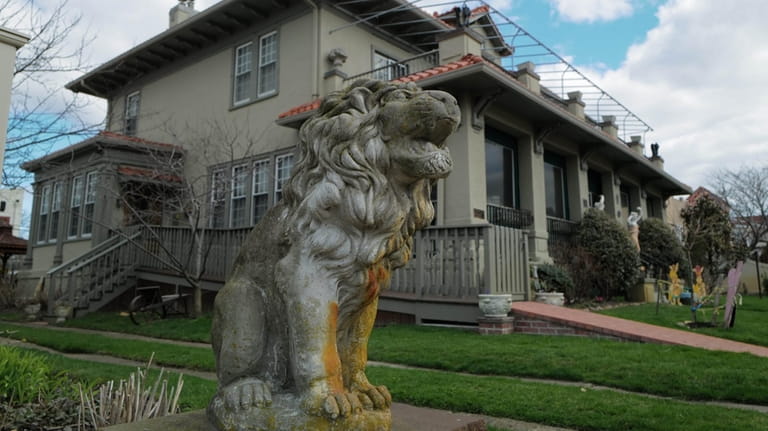
Built in 1909, Marty and Richie Ross' Mediterranean-style house was one of the first dozen homes built in Long Beach. Credit: Debbie Egan-Chin
Follow the red brick road to the home of Marty and Richie Ross, built in 1909 and standing tall: It contains three stories, five bedrooms and an assortment of old treasures.
The couple moved into the Long Beach house in 1991. Marty often went on house tours in Brooklyn and all over Long Island: “Anywhere I could find them,” says Marty, 73. “I loved to see these big homes.”
Then, she found the one, just a short drive from their house in Oceanside. She crossed the bridge and expected to find breezy bungalows in the beach community.
Instead, she discovered towering structures and historic architecture, and of course, what would become her future home. Marty joined the Long Beach Historical Society and kept an eye on it, waiting patiently for it to go on the market.
“I would pass this house all the time and look at it,” she says. “It was just so rundown and so bad that I couldn’t believe a house like that could have ever stood for this long.”
But Marty noticed all the little things: the stone trim, a garden bed, some steps leading up to the front door. “It struck me,” she says. “It was so beautiful. People often said to me, ‘Can we see your rose-colored glasses? Because we don’t see this.’ ”
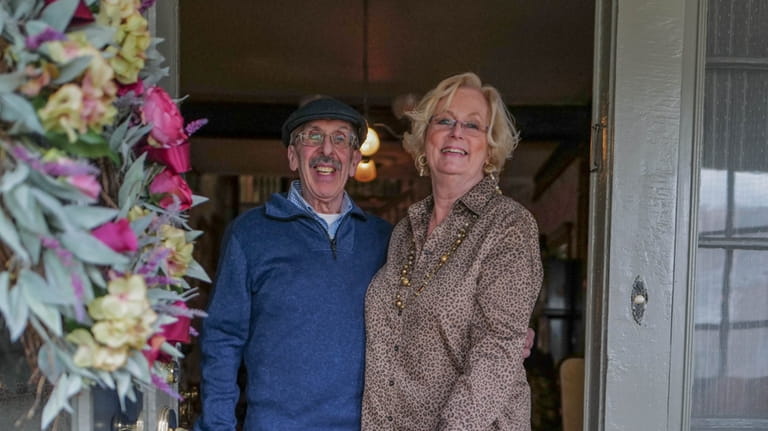
Marty and Richie Ross with their dog Cooper at their 1909 Long Beach historic home, which they bought in 1991. Credit: Debbie Egan-Chin
The Mediterranean-style house was one of the first dozen homes built in the city of Long Beach. It's known as the Pauline Felix House, named for its first owner.
A real estate agent called Marty over a year after she first saw the house, informing her that it was back on the market. It cost them $355,000, with no reduced costs due to damages, says Marty.
“When we stepped in the front door and closed it, plaster fell on our heads,” she remembers with a laugh.
Then, they got to work. There was a leaking ceiling with a mattress collecting the water on the floor below, no electricity on the second floor, no working plumbing in one of the bathrooms and a front porch that was “ready to cave in,” Marty recalls.
During the renovation, Marty and Richie unearthed some of the house’s original qualities. While chipping away at some beige paint in the dining room around the fireplace, Marty found glassy turquoise tile underneath.
Meanwhile, the floors were originally dark red on the main floor, and they decided to paint over it while preserving the wood. But they did save a little splash of the color on the saddle of the door leading into Richie’s favorite room of the house: the bar, which has a working slot machine.
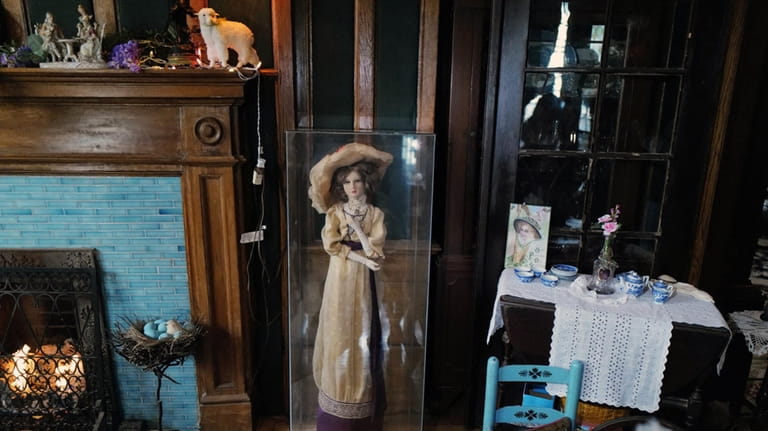
The original turquoise tile around the fireplace revealed itself during the renovation. Credit: Debbie Egan-Chin
“She wouldn’t let me go to the bar, so I brought the bar home,” jokes Richie, 73.
It took six months and the help of a contractor friend to get the house situated enough for Richie, Marty and their five daughters to move in. In total, all of the work over the years has added up to more than $200,000 "and some extra gray hair," Marty says.
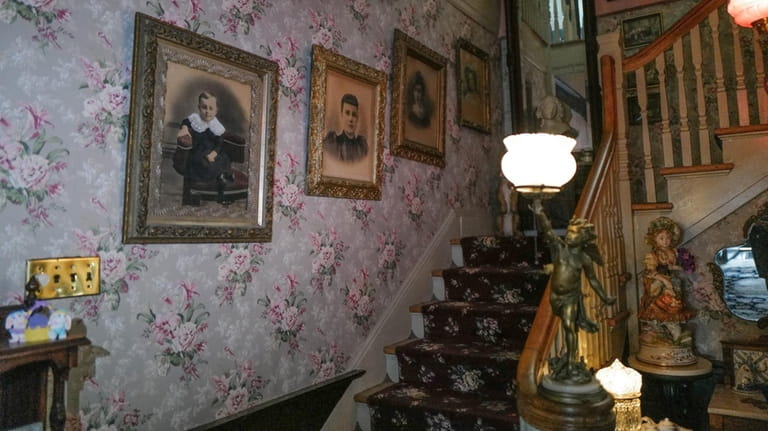
The Rosses have adorned their home with classical paintings and antiques they picked up on the street or thrifted locally. Credit: Debbie Egan-Chin
The couple has adorned their home with classical paintings, dripping light fixtures and lots of antiques, either spotted by Marty on the street or thrifted locally.
“One thing you can feel when you come into this house is history,” she says. “I was excited and happy to be able to work on things that needed the touch of a hand just to bring them back. To see that beauty come out again, it’s a joy in itself.”
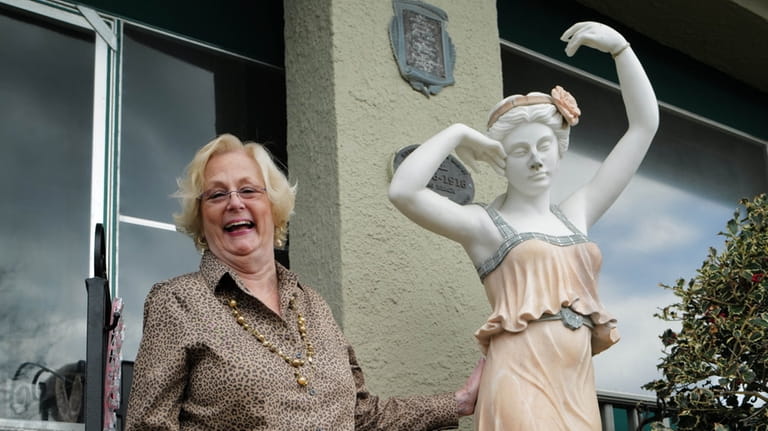
Marty Ross on the porch of her Long Beach home, which she and her husband decorated with antiques they found on the street and at thrift shops. Credit: Debbie Egan-Chin
And when something around the house needs a little fix, it’s no trouble for Marty. She’s “basically never done” repainting, due to the salt air of Long Beach.
But she and Richie get help from their 12 grandchildren, who fill the house during their annual summer visits.
“It’s a pleasure to keep working on different things, to bring the history back,” she says, “because it’s all alive.”
The stuff still works
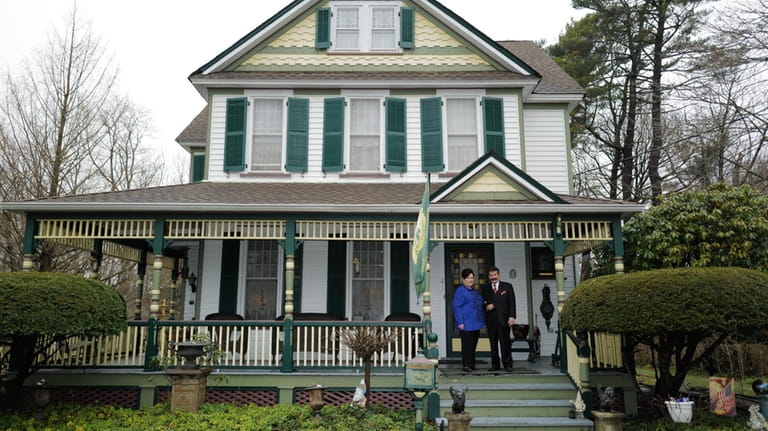
Barbara and Joseph Guidice's Amityville house, built in 1900, has stained-glass windows, a half-circle driveway and a carriage house in the back. Credit: Debbie Egan-Chin
The twinkling sounds of an old music box seem to twirl about and fill a cozy room in Amityville. The curio is a prized possession of Joseph Guidice, whose home joined the National Register of Historic Places about 10 years ago. It was built in 1900.
“It took me four years to have the house nominated and apply for the National Register,” says Guidice, 67.
The process starts with an application to the State Historic Preservation Office. If the house is deemed eligible, the homeowner works with a staff member (who visits the property) and provides documentation of the house's qualities and history. Then, the New York State Board for Historic Preservation lists the property on the State Register. Finally, the nomination is forwarded to the National Park Service for review and listing on the National Register. All of this can take "12 months or longer," according to the FAQ.
The reason Guidice's case took so much longer was partially because the house had six owners since it was built (including Guidice) and the application required proof of ownership from each of them, he says. While some people hire an attorney for this, Guidice decided to do it on his own. He also had to reinstall windows on the third floor, replaced from the original version by a previous owner.
But as a history lover (he’s the vice president of the Amityville Historical Society), Guidice found the process worthwhile.
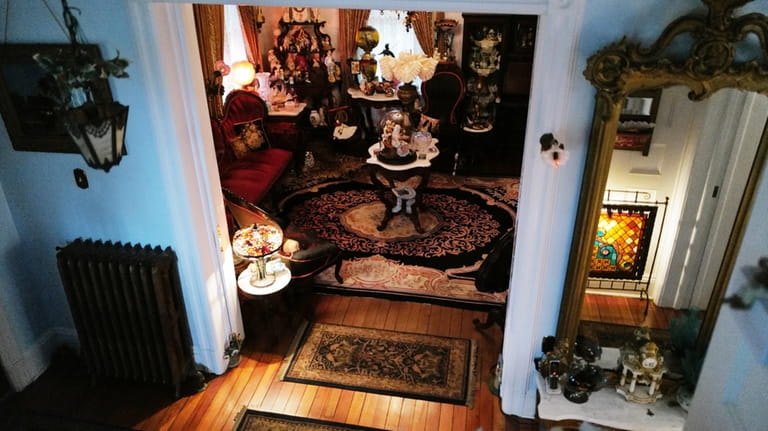
The property is known as the Frank W. Smith House, named for the local business owner who lived there until 1908. Credit: Debbie Egan-Chin
“I really have always loved these houses,” he says. “We used to go to upstate New York to visit houses on the register. It’s a nice status symbol to have something like that, and I’m proud to have one in Amityville.”
Guidice’s property is known as the Frank W. Smith House, named for the local business owner who lived there until 1908. The house contains stained-glass windows, a half-circle driveway and a carriage house in the back. The Guidices paid $520,000 for the historic home.
When they moved there in 2004, Guidice began to replace all of the shutters of the house. Some of them were made of plastic and screwed into the siding, and they were all painted black against the white house.
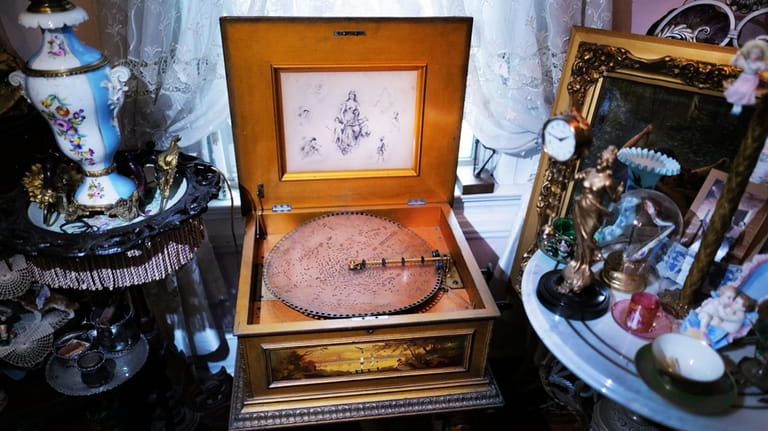
An 1895 music box plays music from "The Tyrolean" in the music room. There's also an 1887 piano that Joseph Guidice plays. Credit: Debbie Egan-Chin
“I had to collect the shutters first,” he says. “The windows are all different sizes. The downstairs [windows] are bigger than the second floor, so it took about six months to collect right size shutters.” Guidice also had to find the proper hinges. He then installed all 52 shutters himself, which saved him money (the total cost for all the shutters was around $1,500).
Guidice also had the house repainted green and yellow, the official colors of Amityville village. The job cost $15,000 — it was that pricey because Guidice opted for a process that burned the previous paint off the house, rather than allowing the contractors to use a drill that would leave gouges in the wood.
Inside, there’s a music room (with a piano from 1887 that Guidice plays) and special features such as pocket doors, which are tucked into the wall and pop out with a push, to separate the rooms.
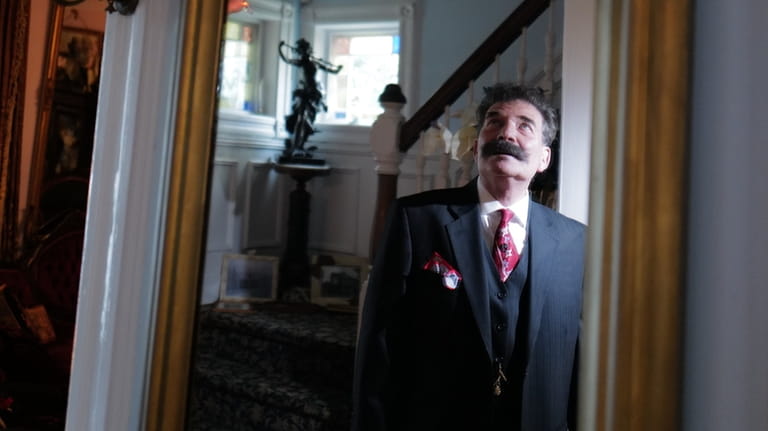
“If you do the proper maintenance on these houses, they’re a pleasure to have," says homeowner Joseph Guidice. Credit: Debbie Egan-Chin
The Guidices even have a cast iron oven from 1900 that burns coal and wood in their basement. In Superstorm Sandy, they lost power for 12 days. They were able to use the oven to bake sweets and even a meatloaf then, Guidice says.
Of course, taking care of this house (and everything in it) requires vigilance.
“Maintenance is key,” says Guidice. “If you do the proper maintenance on these houses, they’re a pleasure to have. People say they’re money pits, but you make it a money pit if you don’t take care of it.”

